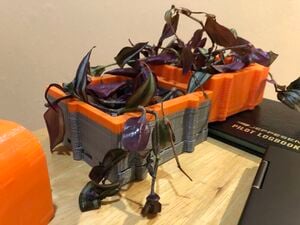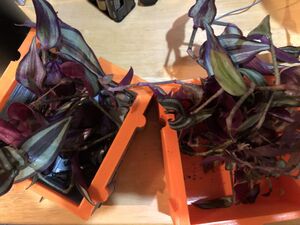
Scalable Aquaponics System Bins. The OSAT project I wanted to tackle was Goal 2, "No Hunger". For this goal, I decided to design a scalable aquaponics system that can be modified to be used in most water sources (pond, lake, river, ocean inlet). The idea behind this prototype is that you can buy a singular block and then scale the layout later. This is especially helpful for third-world countries where individuals are living off about a dollar a day and can only afford one block to start.
This design for a scalable aquaponics system is to be able to purchase one block at a time for people living on about a dollar a day and then sell their plants to buy more blocks. The design of the block is made so that each block can be fit together like a puzzle piece. There is about a 2.5% grade inside the block so that water can flow from the top to the bottom through the soil.
Also included is a small bracket and motor design to push water to the plants. The goal for a small motor is to limit the flow through the soil as well as to reuse a plastic straw to guide the water. If there is no electrical power to be used then an individual would need to make a dam on a lake or live close to a river.
Some articles on the need for aquaponics systems in third-world countries can be found here [1], [2].
Bill of Materials[edit | edit source]
- Full BOM -- Materials needed for fabrication of device and alternative materials
All open source CAD and STL files for 3D printing can be found here [8]. There are two block designs - one with a divider in the middle for smaller plants and one without a divider for larger plants.
For additional components such as the motor, battery tray to run motor, dowel rods, copper wires can be found here for $3.00[9], $2.21[10], and $1.46[11], $1.61 [12]
Tools needed[edit | edit source]
- MOST Delta RepRap or similar RepRap 3-D printer
- PLA filament
- some sort of glue to glue components together (if desired)
- Electricity for motor (if needed)
Skills and knowledge needed[edit | edit source]
The design of this aquaponics system is easy to setup, but for more knowledge on how these types of systems work here are two links to a good article and video on how they work.
Technical Specifications and Assembly Instructions[edit | edit source]
- Print and Assembly Instructions
- To successfully print this design you can only print one block at a time (One with middle divider or one without). When printing and using a slicer make sure that the opening of the block is facing up in the Z direction. This will make sure that there are minimal overhanging areas. If desired you can add a support structure the area that needs them (inlet and outlet for water).
- After printing a block take a 1/4 inch dowel rod and insert it into one of the holes on the bottom. If hole is too tight you may need to shave some of the plastic off. If the dowel fits cut four pieces each the same length and insert to all four holes on the block (length is determined by water depth). The block should be several inches above water. Place structure into a shallow area of water.
- Once placed in water set up the motor with a straw at the intake and place on block so that water flows out and into the top of the slope in the block.
- Place all soil and plants into block and wait to grow.
If adding another block repeat substeps 1 through 4. If adding a block to the front or back of the system dowel rods will need to be different lengths. Simply slide the block into the matching puzzle piece slot. If placing side-by-side slide into the block and add another motor.
- Print time estimate: About 5 hours at 20% infill for block, About 1 hour for motor components
- Assembly time estimate: About 15 minutes
- Assembly (place cylindircal components together)

Common Problems and Solutions[edit | edit source]
- Make sure that the puzzle pieces fit together properly
- Make sure that holes for water align properly so that it can flow from one block to another
Cost savings[edit | edit source]
- For block alone it would cost about $0.66
- For adding other components it would total about $8.94
- No current commerical equivalent
Benefited Internet Communities[edit | edit source]
- Backyard Aquaponics[15]
- Aquaponics Nation [16]
- DIY Aquaponics [17]
- Practical Aquaponics Forum [18]
- Urban Aquaponics [19]
References[edit | edit source]
- ↑ Article:Aquaponics-for-Developing-Countries.pdf, (2005) Available: https://www.aquaponics.com/wp-content/uploads/articles/Aquaponics-for-Developing-Countries.pdf
- ↑ Article: Aquaponics: a sustainable solution to food insecurity?, (2014) Available: https://www.theguardian.com/global-development-professionals-network/2014/oct/02/aquaponics-a-sustainable-solution-to-food-security